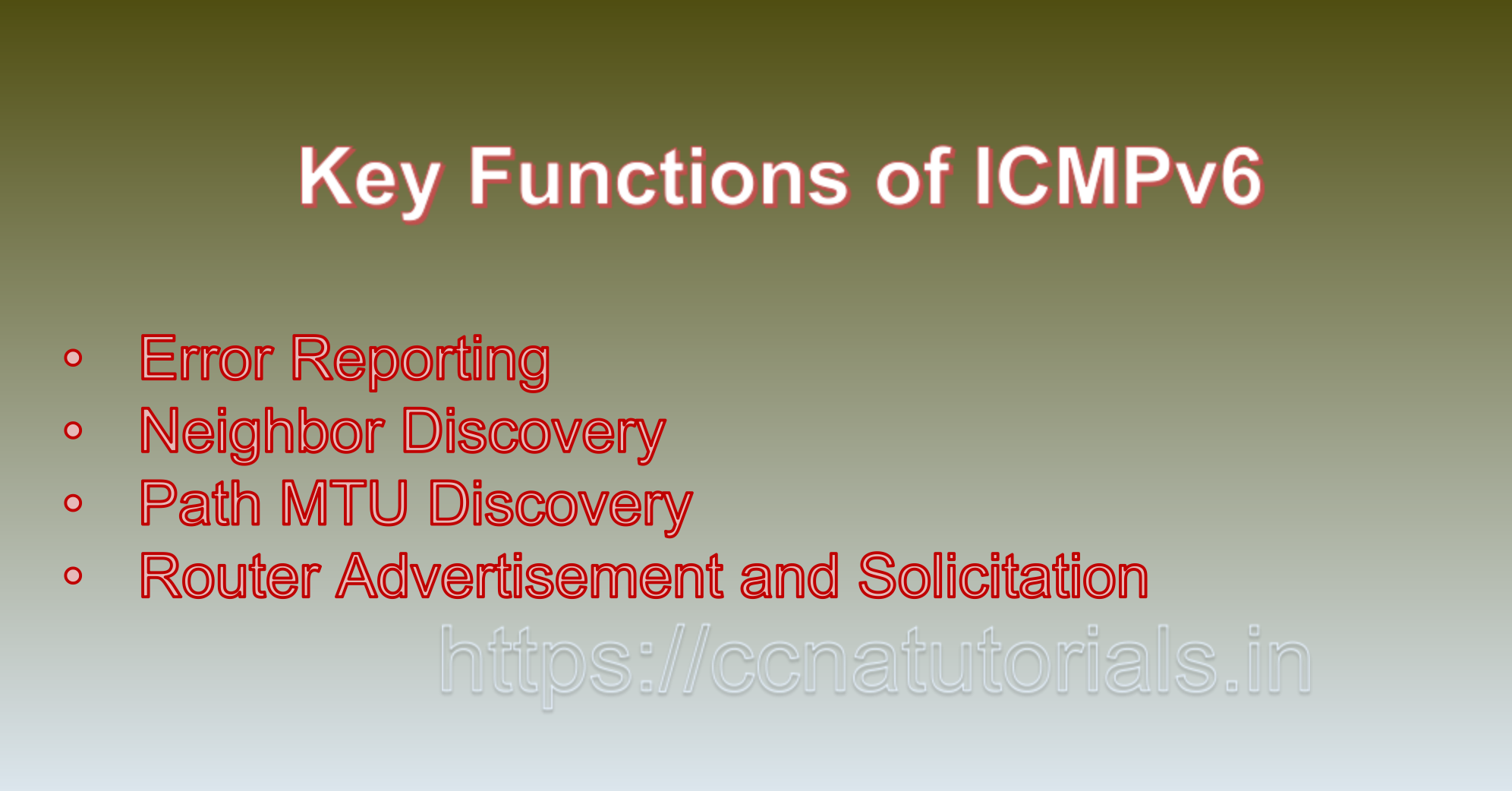Contents of this article
In this article, I describe IPv6 Internet Control Message Protocol (ICMPv6) in details. The IPv6 Internet Control Message Protocol (ICMPv6) is an integral part of the IPv6 protocol suite, serving as a vital communication mechanism for network devices to exchange diagnostic and error information. Similar to its IPv4 counterpart, ICMPv6 enables devices to communicate network-related issues, such as unreachable hosts or network congestion, back to the source or the sender. In this article, we’ll delve into the workings of IPv6 Internet Control Message Protocol (ICMPv6), its key functions, and provide illustrative examples to enhance understanding.
Key Functions of ICMPv6:
IPv6 Internet Control Message Protocol (ICMPv6) serves several important functions in IPv6 networks, aiding in network troubleshooting, path MTU discovery, neighbor discovery, and more. Let’s explore some of its key functions:
1. Error Reporting:
ICMPv6 allows routers and hosts to notify the sender of a packet about errors encountered during the packet’s journey through the network. This includes scenarios like unreachable destinations, time exceeded, and parameter problems.
2. Neighbor Discovery:
IPv6 networks use ICMPv6 for neighbor discovery, which involves determining the link-layer addresses of neighbors on the same network segment. This is crucial for processes like address resolution (finding the MAC address for a given IPv6 address) and duplicate address detection.
3. Path MTU Discovery:
Path Maximum Transmission Unit (PMTU) discovery enables nodes to determine the maximum size of a packet they can send without fragmentation. This ensures efficient packet delivery by avoiding fragmentation and reassembly.
4. Router Advertisement and Solicitation:
Routers use ICMPv6 to advertise their presence on a network segment and provide configuration information to hosts. Hosts can also solicit router advertisements to refresh their configuration or to learn about changes in the network.
IPv6 Internet Control Message Protocol (ICMPv6) Message Types:
IPv6 Internet Control Message Protocol (ICMPv6) includes several message types, each serving a specific purpose. Let’s examine some of the most notable ones:
1. Echo Request and Echo Reply (Ping):
Just like ICMP in IPv4, ICMPv6 includes Echo Request and Echo Reply messages. These are commonly used for network diagnostics, often referred to as “ping.” An Echo Request is sent to a destination, and the destination responds with an Echo Reply.
2. Destination Unreachable:
This message is generated by routers or hosts to indicate that a destination (host or network) is unreachable. This could be due to network issues, routing problems, or firewall rules.
3. Time Exceeded:
If a packet exceeds its time-to-live (TTL) value while traversing the network, routers send a Time Exceeded message back to the source to indicate that the packet was discarded.
4. Parameter Problem:
This message type is used to report errors in the header of an IPv6 packet, such as unrecognized or inconsistent header fields.
5. Router Advertisement and Router Solicitation:
Routers send Router Advertisement messages to inform hosts about their presence and configuration information. Hosts can solicit these advertisements by sending Router Solicitation messages.
6. Neighbor Solicitation and Neighbor Advertisement:
Neighbor Solicitation messages are used by hosts to resolve the link-layer address of a neighbor for a given IPv6 address. The Neighbor Advertisement messages are used to respond to Neighbor Solicitation messages or to announce changes in link-layer addresses.
IPv6 Internet Control Message Protocol (ICMPv6) Example: Path MTU Discovery
Path MTU Discovery is an important function of ICMPv6 that ensures efficient packet delivery by avoiding fragmentation. Here’s how it works:
1. Sender Initiates Communication:
Imagine a sender wants to send a large packet to a destination.
2. Packet Fragmentation Check:
Before sending the packet, the sender checks the Maximum Transmission Unit (MTU) of the path to the destination. MTU is the maximum size a packet can be without fragmentation.
3. Packet Size Adjustment:
If the packet size is larger than the path’s MTU, the sender reduces the packet size to fit within the MTU.
4. Initial Transmission:
The sender sends the packet to the destination.
5. Router MTU Check:
As the packet traverses routers on its path, each router checks whether the packet size exceeds its outbound interface’s MTU.
6. Router MTU Exceeded:
If a router finds that the packet size exceeds the outbound interface’s MTU, it generates an ICMPv6 Packet Too Big message and sends it back to the sender.
7. Sender Receives Packet Too Big:
The sender receives the ICMPv6 Packet Too Big message and learns the MTU of the router’s outbound interface.
8. Packet Retransmission:
The sender adjusts the packet size to match the smallest MTU encountered and retransmits the packet.
9. Repeat Process:
This process continues until the packet reaches its destination without further fragmentation.

IPv6 Internet Control Message Protocol (ICMPv6) in short
ICMPv6, the successor to ICMP in IPv4, plays a crucial role in IPv6 networks by facilitating error reporting, neighbor discovery, and path MTU discovery. Through its message types and functionalities, ICMPv6 enables efficient network troubleshooting, enhances packet delivery, and assists in maintaining the overall health of the network. Understanding ICMPv6 is essential for network administrators and engineers to effectively diagnose and address network-related issues in IPv6 environments.
IPv6 Internet Control Message Protocol (ICMPv6) Explained with Examples
The Internet Control Message Protocol version 6 (ICMPv6) is a crucial component of the IPv6 networking suite. Just as its predecessor, ICMP for IPv4, ICMPv6 is designed to manage error reporting and diagnostic functions within IP networks. However, ICMPv6 offers several improvements and enhancements over its IPv4 counterpart to better accommodate the unique features of IPv6. This article provides an in-depth understanding of ICMPv6, its purposes, message types, and real-world examples.
Purpose of IPv6 Internet Control Message Protocol (ICMPv6):
ICMPv6 serves multiple functions in an IPv6 network:
1. Error Reporting:
ICMPv6 is responsible for reporting errors encountered during packet processing, such as unreachable destinations, time exceeded in transit, and fragmentation errors.
2. Network Management:
ICMPv6 supports network management tasks by providing tools for network administrators to diagnose connectivity issues, troubleshoot routing problems, and measure network performance.
3. Neighbor Discovery:
ICMPv6 includes Neighbor Discovery Protocol (NDP), which enables automatic address configuration, neighbor discovery, and duplicate address detection in IPv6 networks.
4. Router Advertisement and Solicitation:
ICMPv6’s Router Advertisement (RA) and Router Solicitation (RS) messages facilitate automatic configuration of IPv6 hosts on a network.
5. Path MTU Discovery:
ICMPv6 aids in determining the Maximum Transmission Unit (MTU) size for a given path to avoid fragmentation.
IPv6 Internet Control Message Protocol (ICMPv6) Message Types and Examples:
ICMPv6 comprises several message types, each serving a distinct purpose. Let’s explore some of these message types with examples:
1. Echo Request and Echo Reply (Ping):
– Echo Request (Type 128): This message is commonly known as a “ping” request. It is used to determine whether a host is reachable and responsive on the network.
– Echo Reply (Type 129): The host responds with an Echo Reply when it receives an Echo Request. This response indicates that the target host is operational and reachable.
Example: Suppose you want to check if a remote IPv6 host with address 2001:db8::1 is responsive. You send an Echo Request (ping) packet to that address. If the host is reachable, it replies with an Echo Reply.
2. Destination Unreachable (Type 1):
– This message type is used to indicate that a destination host or network is unreachable due to various reasons such as no route, fragmentation needed, or communication prohibited.
Example: If you attempt to access a website using an IPv6 address, but there is no route to that address, the router might send a Destination Unreachable message back to inform you of the issue.
3. Time Exceeded (Type 3):
– This message is sent by a router when a packet’s Time-to-Live (TTL) field reaches zero. It indicates that the packet has been discarded and allows diagnosing routing loops.
Example: If a packet traverses multiple routers and its TTL reaches zero before reaching the destination, the router encountering the expired TTL sends a Time Exceeded message back to the source.
4. Neighbor Discovery Protocol (NDP) Messages:
– NDP includes several message types such as Router Advertisement (RA), Router Solicitation (RS), Neighbor Solicitation (NS), and Neighbor Advertisement (NA).
– RA messages are sent by routers to announce their presence and provide network configuration information.
– RS messages are sent by hosts to discover routers on the network.
– NS and NA messages are used for address resolution and neighbor discovery.
Example: When a new host joins an IPv6 network, it sends a Router Solicitation (RS) message to inquire about available routers. Routers respond with Router Advertisement (RA) messages, providing necessary configuration information.
5. Packet Too Big (Type 2):
– This message type assists in Path MTU Discovery, helping a sender determine the appropriate MTU size for a specific path to avoid fragmentation.
Example: If a router receives a packet that exceeds its outgoing interface’s MTU, it sends a Packet Too Big message back to the sender, indicating the need for fragmentation or MTU adjustment.
Conclusion of IPv6 Internet Control Message Protocol (ICMPv6):
ICMPv6, the evolution of ICMP for IPv4, is an integral part of the IPv6 networking stack. It fulfills various functions, including error reporting, network management, and neighbor discovery. With message types like Echo Request/Reply, Destination Unreachable, Time Exceeded, and Neighbor Discovery Protocol messages, ICMPv6 empowers network administrators to diagnose issues, maintain connectivity, and optimize packet delivery in IPv6 networks. By understanding the diverse ICMPv6 messages and their roles, network professionals can effectively manage and troubleshoot IPv6 networks, contributing to seamless and efficient communication on the modern Internet. You may contact us for any query related to this article.






